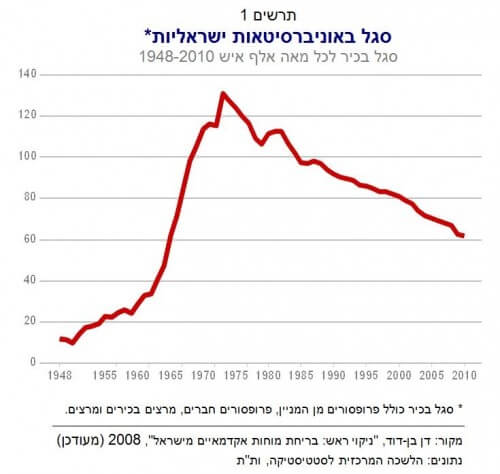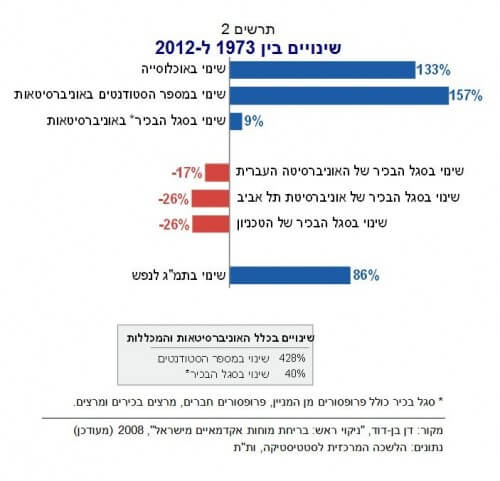Since 1973, the number of students has more than doubled the number of professors. • The universities have moved from employing academic researchers (whose cost is higher) to expanding the outsourcing of teaching and employing external lecturers who are not researchers • The "brain drain" from Israel to the United States is a phenomenon that has no parallel in the Western world

With the start of the academic school year just around the corner, the Taub Center publishes a research paper on the state of higher education in Israel - which will appear in the center's "State of the State Report 2013".
As the editor of the study, Prof. Dan Ben-David, points out: "During the two and a half decades since its establishment, Israel has established world-class research universities. Despite the flooding of the country with refugees who arrived in Israel with only the clothes on their bodies, a period of austerity in which there was a shortage of food, recurring all-out wars and severe budget constraints - already in the early 1s, Israel had seven important research universities and the number of senior faculty members per capita soared and reached levels similar to those in the United States" ( Chart XNUMX).
"On the other hand, since the XNUMXs Israel is considerably richer and has more capabilities to develop the higher education system, but the country has changed direction dramatically. For a period of about four decades, the universities have consistently dropped from the state's order of priorities - as can be clearly seen from the data."
Chart 2 shows the changes in the population and the demand for higher education between 1973 and 2010, and the response of the State of Israel in terms of the number of academic positions it chose to fund.

The Taub Center's research found that while Israel's population increased by 133 percent, the student population at research universities increased by 157 percent, and the number of students in the entire higher education system in Israel (including colleges) increased by 428 percent. Compared to the massive increase in the number of students, the number of senior faculty members at research universities increased by only 9 percent, while the overall change in senior academic staff at all colleges and universities increased by only 40 percent. In fact, over the past 35 years, the number of senior faculty members at the two leading universities in Israel has not only not increased, but has also decreased. In 2010 there were 17 percent fewer senior faculty positions at the Hebrew University than in 1973 and 26 percent fewer positions at Tel Aviv University. The Technion also lost over a quarter (26 percent) of the senior faculty positions it had four decades ago.
Chart 3 shows the increase in the number of students per senior faculty member between 1977 and 2010. As Prof. Ben-David points out, "The situation is much worse than these numbers reflect, when it comes to students currently studying for advanced degrees and the possibility of transferring the latest findings from the front of knowledge to the next generation of researchers." It was found that the number of doctoral students in relation to the number of senior faculty members increased from less than one student to more than two students per faculty member and the number of master's degree students per faculty member increased fourfold, from 2 to 8.
To fill the gap in teaching, research universities turned to outsourcing. The Taub Center's research finds that these added to their ranks teachers from abroad in increasing numbers at the expense of the required increase in the number of senior faculty members with tenure or on the tenure track (Chart 4). In 1986, the proportion of lecturers from abroad was 13 percent of all senior faculty members. By 2010, this rate had risen to 46 percent.
As Prof. Ben-David points out, "This cost-effective solution, which reflects the declining public interest in funding research universities - as reflected in the state budget - had two important negative consequences. The first is the deterioration in the quality of teaching that students receive - especially when it comes to advanced degrees - coming from people who are not actively engaged in advanced research. The second is that it is possible that those who serve as teachers from abroad today intended to continue a research track after completing their studies and develop an academic career, but the growing lack of senior faculty standards in Israel's research universities, relative to the number of graduating research students, caused many of them to abandon the research track or find research jobs abroad .”
The Taub Center's research shows that Israel is at the top of the countries that suffer from academic brain drain to the United States - and this by orders of magnitude significantly higher than the other countries (Chart 5). The study revealed that the brain drain figures have worsened in recent years: in 2003-2004 there were 25 Israeli lecturers in the United States for every 100 senior faculty members in all universities and colleges in Israel, compared to 1-4 foreign lecturers in American universities from all other countries of the world (except Canada, with 12 lecturers in the USA) for every 100 in the mother country. By the 2007-2008 academic year (the most updated data available), Prof. Ben-David found that the academic brain drain from most countries to the US had decreased - while the brain drain from Israel to the United States had increased to 29 lecturers out of every 100 in Israel.
Prof. Dan Ben-David concludes: "Education is perhaps the most important infrastructure of a country. Israel is home to some of the leading academic research institutions in the world, and they may be the key to upgrading the primary and secondary education systems and increasing labor productivity (which is very low compared to other developed countries), which is so essential for coping in a modern global economy. Over the past four decades, Israel - now much richer than it was in its early years, with a considerably larger budget than it had in the XNUMXs and XNUMXs - has steadily neglected its academic institutions, placing an increasing risk on its future, which depends entirely on its ability to remain at the forefront of technology. . It's not too late to change direction, but it requires Israel to return the country's national priorities to the path of the first decades - a path that ultimately allowed Israel to become the 'start-up country' it must be if it wanted to survive in its hostile neighborhood."
The Taub Center for Social Policy Research in Israel, headed by Prof. Dan Ben-David, is an independent, non-partisan institution for socio-economic research based in Jerusalem. The center gives the leading decision makers in Israel and the general public an overview of the economy and society. The professional staff of the center and the interdisciplinary teams - which include prominent researchers from the academy and leading experts from the policy fields - conduct studies and offer policy recommendations on the main socio-economic issues facing the country.

5 תגובות
Moses
Who does have a contribution to the state?
These academics have no contribution to the country. They just research theoretical issues and publish their findings in international magazines. There is no reason to return them to Israel.
The report is completely inaccurate for two reasons.
One reason. Some (compared to the past) of the senior academics have moved to teaching positions in colleges, academics who remain in colleges will not be counted in the research (therefore they will be removed from the system and their number will apparently decrease).
Second reason. In the last decades, many senior academics work in applied research outside the academic system, for example medicine, for example high-tech. That's why they are also reduced only seemingly compared to the past.
What is really unfortunate is that today the academic system cannot provide research positions, in areas where basic research is required (compared to applied research which, as mentioned, can be done outside the academic system). I don't see a simple solution to this, because it is a heavy budget expenditure that cannot be imposed on the state.
The question of the cost of living in the country that motivates academics to emigrate is a separate matter because it applies to all sectors (even non-academic sectors).
The situation in the Kents, I can give you a "report from the field" and tell you that a large part, but less than half of the bachelor's degree students, especially in the engineering subjects, plan to use their degree as a "springboard" to the USA that will help them obtain "permanent resident" status and, in the long run, citizenship. The reason is known: the disgraceful attitude of the government to the citizens, which is expressed in the cost of living and the extremely poor functioning to the point of non-existence of the basic government services for the citizen.
Every word written in the article is correct! It's a shame they didn't mention the grandmother's story system that was designed to bring back descending scientists and only upon their landing, to discover to them that all the promises made were forgotten.... Higher education in Israel is in a state of collapse. When they check the situation in high schools and colleges, they will find that the destruction is already in progress....